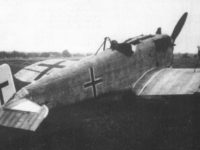The Junkers D.I was one of the few all-metal aircraft that came to the end of the war from the Junkers-Fokker A.G. were built. Relocated to the front in October 1918, these aircraft came too late to intervene in the air war.
Development and construction:
Based on the experience of the Junkers J 7 in early 1918, the development of a successor model was worked on. Previously, under pressure from the German government, the two companies Fokker Aeroplanbau and Junkers & Co. merged into the Junkers-Fokker Werke AG, so that both Junker and Fokker themselves participated in the development.
The special thing about the D.I was the duralumin corrugated iron, which covered the plane almost completely. The experience with this material showed that these aircraft were much better protected against shelling and weathering and thus were superior to the usual wooden constructions. However, this development also led many pilots and high-ranking military leaders to be skeptical about these aircraft and consider them unsustainable.
In April 1918, the first flight of the prototype took place, in May this was registered for the flight competition in Berlin Adlershof. At this time still equipped with the 185 hp BMW IIIa engine, the aircraft could convince only a few present. Successful pilots such as Bruno Loerzer or Hermann Goering considered the aircraft more suitable for fighting balloons than as a fighter plane. One of the few advocates was the naval officer Gotthard Sachsenberg.
Despite the reservations, initially 20 aircraft were ordered, by October 1918, a total of 28 aircraft were brought to the front.
Use in the First World War:
In October 1918, the 28 built Junkers D.I reached the western front near Flanders. Nothing is known about their missions.
A few weeks later, the German Reich had to agree to the terms of the truce. Some of the remaining aircraft were still used until 1919 in the Baltic States in the fight against the Communists.
The only surviving copy of a Junkers D.I is today in the Musée de l 'Air et de l'Espace. This plane fell into the hands of the French troops when the German army had to withdraw from Belgium and left the aircraft at the airfield.
Technical specifications:
| Designation: | Junkers D.I |
| Country: | German Empire |
| Typ: | Fighter plane |
| Length: | 7,25 meters |
| Span: | 9,08 meters |
| Height: | 2,25 meters |
| Mass: | 654kg empty |
| Crew: | Max. 1 |
| Engine: | Water-cooled 6-cylinder inline engine Benz Bz IIIaü 185 hp |
| Maximum speed: | 220 km/h |
| Reach: | 300 kilometers |
| Armament: | 2 x synchronized machine guns 7,92 mm LMG 08/15 |
You can find the right literature here:
Fokker Dr I Aces of World War 1 (Aircraft of the Aces)
Undoubtedly the most famous fighter type to see service on either side during World War 1, the Fokker Dr I was a revelation when it entered service on the western front in 1917. Manfred von Richthofens JG 1 circus was the first Jasta to completely re-equip with the new fighter, and in the skilled hands of its numerous aces the Dr I proved a formidable opponent. The Dr I remained in service on the Western Front until replaced by the superior Fokker D VII in May 1918. Just weeks prior to that, however, Germanys leading ace, the great Red Baron, had been killed at the controls of a Dr I.
Friedrichshafen Aircraft of WWI: A Centennial Perspective on Great War Airplanes (Great War Aviation) (Volume 21)

Friedrichshafen Aircraft of WWI: A Centennial Perspective on Great War Airplanes (Great War Aviation) (Volume 21) Paperback – February 16, 2016
This book describes and illustrates the development of Friedrichshafen aircraft of WWI with text, 540 photos, 18 in color, 37 color profiles, production quantities and serial numbers of aircraft, and aircraft dimensions and performance specifications. In addition, there are 26 official SVK drawings and 11 aircraft are illustrated in scale drawings to 1/48 (4) or 1/72 (7) scales. The book has 312 pages and is of interest to aviation historians, enthusiasts, and modelers alike.
German and Austro-Hungarian Aircraft Manufacturers 1908-1918
Much has been written about the British aircraft of the First World War, but little has surfaced about the aircraft of the Axis powers, Germany and Austria. Here, Terry C. Treadwell tells the story of the aircraft from companies such as Fokker, builder of the famous triplane, as fl own by Baron von Richthofen's Flying Circus, AEG, Albatros, Junkers and Hansa. From reconnaissance aircraft to state-of-the-art bombers that could reach London, this is the definitive guide to aircraft of the Axis powers during the First World War. The aircraft are explained in detail and a history of each company is provided, making this an excellent source book for aircraft enthusiasts, model makers and those interested in the air war over the trenches of France and Belgium, as well as further afield in the Italian campaign.
The Zeppelin in Combat: A History of the German Naval Airship Division
The standard reference now revised and expanded. Dr. Robinson has opened up his vast photo archives to enhance this new edition of his classic work. Much of the new photographic material is published here for the first time.
This post is also available in:
 Deutsch (German)
Deutsch (German)  Français (French)
Français (French)  Italiano (Italian)
Italiano (Italian)  简体中文 (Chinese (Simplified))
简体中文 (Chinese (Simplified))  Русский (Russian)
Русский (Russian)  Español (Spanish)
Español (Spanish)  العربية (Arabic)
العربية (Arabic)

















